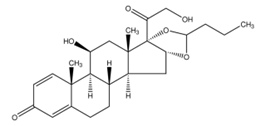INTRODUCTION
Budesonide is in a class of medications called corticosteroids. It works by decreasing inflammation (swelling) in the digestive tract of people who have Crohn’s disease or ulcerative colitis. or in the kidney of people with nephropathy.
MANUFACTURE
It is manufactured by the reaction of 16α-hydroxyprednisolone (11β,16α,17α,21-tetrahydroxypregna-1,4-diene-3,20-dione) with butyraldehyde in dioxane, using perchloric acid as catalyst.
| Synonym | 16,17-Butylidenebis(oxy)-11,21-dihydroxypregna-1,4-diene-3,20-dione |
| CAS no. | 51333-22-3 |
| EINECS no. | 257-161-7 |
| Molecular formula | C25H34O6 |
| Molecular weight | 430.5 g/mol |
| Structure |  |
APPLICATIONS
| It is used for the treatment of: |
|---|
| Asthma |
| Inflammatory bowel disease |
| Allergic rhinitis |
| Eosinophilic esophagitis |
| Berger’s disease |
SPECIFICATIONS… (EP)
| Test | Unit | Specification |
|---|---|---|
| Appearance | – | White or almost white, crystalline powder. |
| Solubility | – | Practically insoluble in water, Freely soluble in methylene chloride, sparingly soluble in alcohol (96%). |
| Identification | ||
| A) By IR Absorption | – | The IR spectrum of the sample should be concordant with that of a similar preparation of Budesonide standard. |
| B) By TLC | – | The principal spot of the test chromatogram should correspond to the principal spot of reference solution (a) at 254nm and 365nm. |
| C) By Chemical | – | The colour should fade and a clear solution remains. |
| D) By Chemical | – | The solution should turn blue. |
| Loss on drying | % | Not more than 0.5 |
| Epimer A (Second Peak) | % | 40.0 to 51.0 |
| Related Substances (By HPLC) | ||
| Impurity A | % | Not more than 0.2 |
| Impurity D | % | Not more than 0.2 |
| Impurity K | % | Not more than 0.2 |
| Impurity L | % | Not more than 0.2 |
| Unspecified impurities | % | Not more than 0.10 |
| Total impurities | % | Not more than 0.5 |
| Assay (By HPLC) (on dried substance) | % w/w | 97.5 to 102.0 |
| Residual Solvents | ||
| Methanol | ppm | Not more than 1000 |
| Dichloro Methane | ppm | Not more than 600 |
| n-butyraldehyde | ppm | Not more than 150 |
| Benzene | ppm | Not more than 2 |
| Dimethyl formamide | ppm | Not more than 880 |
PACKING
Fiber/HDPE drum.
STORAGE
Store in cool place. Keep container tightly closed in a dry and well-ventilated place.
CERTIFICATION
WHO–GMP, Written Confirmation for EU and CEP.
No matter the quantity you need, our exceptional quality and service will make ExSyn your supplier of choice! If you need any additional information or SDS, please contact us.
Iodine is anon-metallic, dark-grey/purple-black, lustrous, solid element. It is the heaviest and the rarest of stable halogens that can be found on the crust of earth.About fifty percent of all iodine produced and manufactured worldwide is used to form Organoiodine compounds. Iodine is an important element for many health-sustaining processes and essential for human thyroid health.
The product, acronymed Oct-NBE, is an organic compound with a cyclic ring system and a 8-membered hydrophobic chain. The structure renders the chemical special properties leading to its applications in diverse fields.
Nicotine is a hygroscopic, colorless to slight yellow, oily liquid, that is readily soluble in alcohol, ether or light petroleum. It is widely used recreationally as a stimulant and anxiolytic.
The product, acronymed ETD, is an organic compound with a fused bicyclic ring system and an ethylidene group. The structure renders the chemical special properties leading to its applications in diverse fields.
Sodium perchlorate monohydrate is the inorganic compound with the chemical formula NaClO4•H2O. It is the common existence form of sodium perchlorate, which can gradually absorb water in the air to form the monohydrate. Sodium perchlorate monohydrate is white rhombic crystal which is highly soluble in water and in alcohol. Its capacity to undergo redox reactions, liberating oxygen atoms, has been harnessed in the preparation of specialty chemicals, including pharmaceutical intermediates and fine chemicals.
Triphenylphosphine is a common organophosphorus compound that is frequently abbreviated as PPh3 or Ph3P. It is widely used in organic and organometallic compound synthesis because it is an effective reducing agent as well as a neutral ligand. At room temperature, PPh3 crystals are relatively air-stable and colourless.
Potassium chlorate holds significant importance across various industries due to its diverse applications. This white crystalline compound has been utilized for centuries as an essential ingredient in the production of matches, fireworks, and explosives, owing to its ability to release oxygen upon decomposition.
Podophyllotoxin is a non-alkaloid toxin lignan extracted from the roots and rhizomes of Podophyllum species. It is an organic heterotetracyclic compound that has a Furonaphthodioxole skeleton bearing a 3,4,5-trimethoxyphenyl substituent.
Octadecylphosphonic acid (ODPA), a versatile chemical compound, serves as a surfactant and dispersant in applications spanning coatings, lubricants, and corrosion inhibition. With its hydrophobic octadecyl chain linked to a phosphonic acid group, it excels in surface modification, boosting adhesion in metal surfaces.
